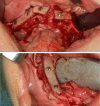Dentin dysplasia type I: a challenge for treatment with dental implants
- PMID: 17714586
- PMCID: PMC1995192
- DOI: 10.1186/1746-160X-3-31
Dentin dysplasia type I: a challenge for treatment with dental implants
Abstract
Background: Dentin dysplasia type I is characterized by a defect of dentin development with clinical normal appearance of the permanent teeth but no or only rudimentary root formation. Early loss of all teeth and concomitant underdevelopment of the jaws are challenging for successful treatment with dental implants.
Methods: A combination of sinus lifting and onlay bone augmentation based on treatment planning using stereolithographic templates was used in a patient with dentin dysplasia type I to rehabilitate the masticatory function.
Results: (i) a predisposition for an increased and accelerated bone resorption was observed in our patient, (ii) bone augmentation was successful using a mixture of allogenic graft material with autogenous bone preventing fast bone resorption, (iii) surgical planning, based on stereolithographic models and surgical templates, facilitated the accurate placement of dental implants.
Conclusion: Bony augmentation and elaborate treatment planning is helpful for oral rehabilitation of patients with dentin dysplasia type I.
Figures







References
-
- Ommerborn M, Raab W. Allgemeinerkrankungen und Schäden der Zahnhartsubstanzen. Prophylaxe Impuls. 2005;9:66–73.
LinkOut - more resources
Full Text Sources

